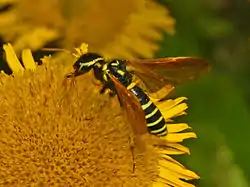Megalodontesidae
The Megalodontesidae (until recently spelled Megalodontidae,[1] a name already in use for a family of fossil molluscs) are a small family of sawflies, containing some 40 species restricted to the temperate regions of Eurasia. Larvae of Megalodontesidae feed on herbaceous plants. They are distinguished from the closely related Pamphiliidae by their serrate or pectinate antennae.[2]
| Megalodontesidae | |
|---|---|
 | |
| Megalodontes sp. | |
| Scientific classification | |
| Kingdom: | Animalia |
| Phylum: | Arthropoda |
| Class: | Insecta |
| Order: | Hymenoptera |
| Suborder: | Symphyta |
| Superfamily: | Pamphilioidea |
| Family: | Megalodontesidae Konow, 1897 |
| Genera | |
| |
References
- International Commission on Zoological Nomenclature (1996). "Opinion 1829. Megalodontidae Konow, 1897 (Insecta, Hymenoptera): spelling emended to Megalodontesidae, so removing the homonymy with Megalodontidae Morris & Lycett, 1853 (Mollusca, Bivalvia)". Bulletin of Zoological Nomenclature. 53 (1): 66–67.
- Hymenoptera of the world : an identification guide to families. Goulet, Henri., Huber, John T. (John Theodore), Canada. Agriculture Canada. Research Branch. Ottawa, Ont.: Centre for Land and Biological Resources Research. 1993. ISBN 0-660-14933-8. OCLC 28024976.CS1 maint: others (link)
- Biolib
- Naturspaziergang
- Aramel.free.fr
- R.B. Benson: Handbook for the identification of British insects. Vol IV: Hymenoptera. 2. Symphyta Section a. Published by the Royal Entomological Society of London, 1951.
This article is issued from Wikipedia. The text is licensed under Creative Commons - Attribution - Sharealike. Additional terms may apply for the media files.